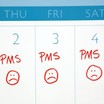Hormones General Info
So.... what are hormones (actually)?
Hormones are often referred to as “chemical messengers.” They carry information and instructions from one group of cells to another. In the human body, hormones influence almost every cell, organ and function. They regulate our growth, development, metabolism, tissue function, sexual function, reproduction, the way our bodies use food, the reaction of our bodies to emergencies and even our moods.
Hormones are chemicals that are made in small organs called glands. Hormones move about the body, usually through the bloodstream, and change or regulate the function of other organs and structures. In effect, the release of hormones is one of the ways that different parts of the body communicate with each other. The hormones we are most concerned about here are estrogen, progesterone, and testosterone. These are made in a woman’s ovaries, the small almond-shaped sex glands in the pelvis that also produce a woman’s eggs.
The sex glands are active during fetal development, but they become relatively inactive throughout infancy and childhood. Then, at puberty, the sex glands kick in bigtime to produce adult sexual development and urges, as well as the mood swings we all associate with puberty. After that, most women then settle into a more or less regular pattern of ovulation.
The ovaries make estrogen and progesterone, as well as various other hormones, in a cyclic fashion, and the levels of these hormones rise and fall with ovulation. For most women, this will be a monthly cycle, interrupted now and then by pregnancy or disrupted by stressful events.


Thought of as the primary female hormone, estrogen builds up the uterine lining, stimulates breast tissue, and thickens the vaginal wall. It also affects almost every other organ in the body. Estrogen plays a critical role in bone building and is thought to have important protective effects on the cardiovascular system.
In 2009, the Mayo clinic determined that if you do not take estrogen replacement after menopause there is a 40% increase in the risk of mortality after menopause from
stroke, heart disease, cancer and many other health conditions that can significantly change quality of life.
Progesterone, which is made only during the second half of the menstrual cycle, prepares the uterine lining for an egg to implant, but progesterone also has other important effects on many of the tissues sensitive to estrogen. Testosterone, also made in the ovaries, plays a role in stimulating sexual desire, generating energy, and developing muscle mass.
The balance of hormones in your body at any given point is affected by many factors. The pituitary gland, at the base of your brain, and your ovaries are constantly communicating via their respective hormones, dictating the changing hormone levels of your monthly cycle and the production of eggs. The pituitary produces follicle-stimulating hormone and other hormones. Stress, body weight, time of day, time of the month, and any medications you take can all cause temporary changes in your hormone levels.
Menopause brings major, permanent changes to the hormone levels and hormone balance of your body. The ovaries stop producing eggs, and they also quit producing their hormones. This does not happen all at once. By their late 30s, many women produce less progesterone, which can lead to heavier, more frequent periods early in the “perimenopause” process. Then the ovaries’ estrogen production tapers off. It is the fluctuations in estrogen production and, later, the lack of estrogen that primarily brings on the discomforts and health concerns that are associated with menopause.
Fluctuating and falling estrogen levels disrupt your internal thermostat, causing vasomotor instability, the scientific name for the process that causes hot flashes. Your sleep cycles and some muscle tone, most notably in the pelvic area, are also affected by the drastic reduction in estrogen levels.
And so is your brain….

Your Brain on Your Menstrual Cycle
Shape Magazine MIND & BODY | July 2, 2014
Guys have it easy. Their bodies are pretty much perpetually locked and loaded when it comes to their reproductive capabilities. Women, on the other hand, have to endure a monthly ebb and flow of hormones in order to make conception possible.
Apart from preparing your body for pregnancy, those hormonal fluctuations have some serious repercussions for your brain. From the way you dress to the size of your brain, your menstrual cycle will mess with you in multiple ways, research shows. Here, experts explain exactly what’s going on in your head throughout the (roughly) 28 days of your cycle.
Day 1 to Day 5 (Your Period)
Hormonally, the first day of bleeding is a relatively quiet time, says Louann Brizendine, M.D., a neurobiologist at the University of California, San Francisco, and author of The Female Brain. Your brain and body’s levels of the three major hormones that control your cycle—estrogen, progesterone, and testosterone—are about as low and balanced as they’ll be, Brizendine explains.
But research shows that, starting soon, an uptick in hormone-like compounds called prostaglandins may leave you cramp-y or nauseated as your uterus releases its unfertilized egg and any extra blood or tissue that accumulated as your body prepared for pregnancy. You’ll also start to produce more estrogen and testosterone as your period progresses, although levels of both are still pretty low, Brizendine says. That uptake in estrogen should stimulate the release of feel-good chemicals like endorphins, which wipe out any remnants of the crankiness or foggy thinking you may have experienced during PMS, studies show. (More on that later.)
Day 5 to Day 14
Your estrogen levels in particular will skyrocket between now and just before you start ovulating in order to prepare your uterus for fertilization. “Estrogen acts like fertilizer for brain cells,” Brizendine says. That leads to a roughly 25 percent growth of synaptic connections in your hippocampus, which controls functions like your short-term memory and decision-making, she explains.
Rising estrogen levels also sharpen your verbal fluency, Brizendine adds. “I always tell my female students to plan to take their oral exams the day before ovulation, when there estrogen levels are peaking.” At the same time, ramped up testosterone production increase a woman’s sex drive. Combined with the swell of brain activity from estrogen, that leaves you feeling more social, flirtatious, mentally sharp, and energetic, Brizendine says. Whether or not you realize it, you’re also more likely to wear extra makeup and “Notice me!” colors like red, studies have found. Why? “You’re advertising that you’re fertile, even if you’re not conscious of it,” Brizendine explains. Testosterone also boosts your sense of competition, which means you’re more likely to feel threatened by other women, research shows.
Even your sense of smell is affected. Peaking estrogen levels make your nose more attuned to pheromones, or chemicals the body releases that can trigger sexual desire, studies show. “There’s a famous dirty t-shirt experiment,” Brizendine says. “During the week before ovulation, women were attracted to men’s sweat on their dirty t-shirts. It’s amazing how estrogen can change our behavior.”
Day 14 to Day 25
Around the time you start ovulating, there’s evidence that you view men’s faces differently. Reward regions of your brain light up, shows research from Indiana University’s Kinsey Institute. At the same time, the frontal cortex, which typically manages your self-control, may power down, the researchers found. As a result, you might find yourself attracted to more masculine looking faces, and you’re more likely to engage in risky sexual behavior, the study authors say.
Also, thanks to the high amounts of estrogen you were producing for the last week, grey matter in your brain has expanded, particularly in your hippocampus, shows research from Germany. That growth peaks at the start of ovulation and may improve your memory and your ability to process information, the German study authors say. But once you’ve begun ovulating, your estrogen and testosterone stores plummet, which studies show can leave you feeling a little cranky. At the same time, levels of another hormone, progesterone, begin to swell, Brizendine says. “Progesterone acts on the same brain receptors as Valium, so it’s very calming,” she explains. “This hormone is preparing your uterus and uterine lining for implantation in case there’s fertilization of the egg.” If you were pregnant, the fertilized egg would trigger a continued release of progesterone, she adds.
Unfortunately, as your ovulation ends and your progesterone levels continue to rise, your hippocampus and the other parts of your brain become less active, meaning your short-term memory, verbal fluency, and general sociability may all fall, she explains. The German research shows your brain’s grey matter stores also shrink.
Day 25 to 28
When your body realizes it’s not pregnant and prepares to omit its unfertilized egg, your progesterone and estrogen levels both plummet. The lack of those hormones causes an uptake in your brain’s levels of stress chemicals like cortisol, which further contribute to your bad vibes during PMS, studies have found. Headaches, poor sleep, and a general absence of energy and enthusiasm are all pretty common, Brizendine says.
Things could be worse. Your brain goes through a surge of activity in its medial orbitofrontal cortex during the premenstrual phase of your cycle, according to a study in the Proceedings of the National Academy of Sciences. The study authors say this brain activity may help women maintain control of their moods despite their big hormonal fluctuations. For those who experience severe PMS mood swings, your hormone levels might be especially high or variable, the authors say. But look on the bright side: In just a few days, this whole roller-coaster hormone cycle will start all over again, Brizendine says. Your estrogen levels will pick up again as your period commences, and the negative PMS symptoms will evaporate, she adds.
References
The Female Brain, LuAnn Brizendine, MD.
